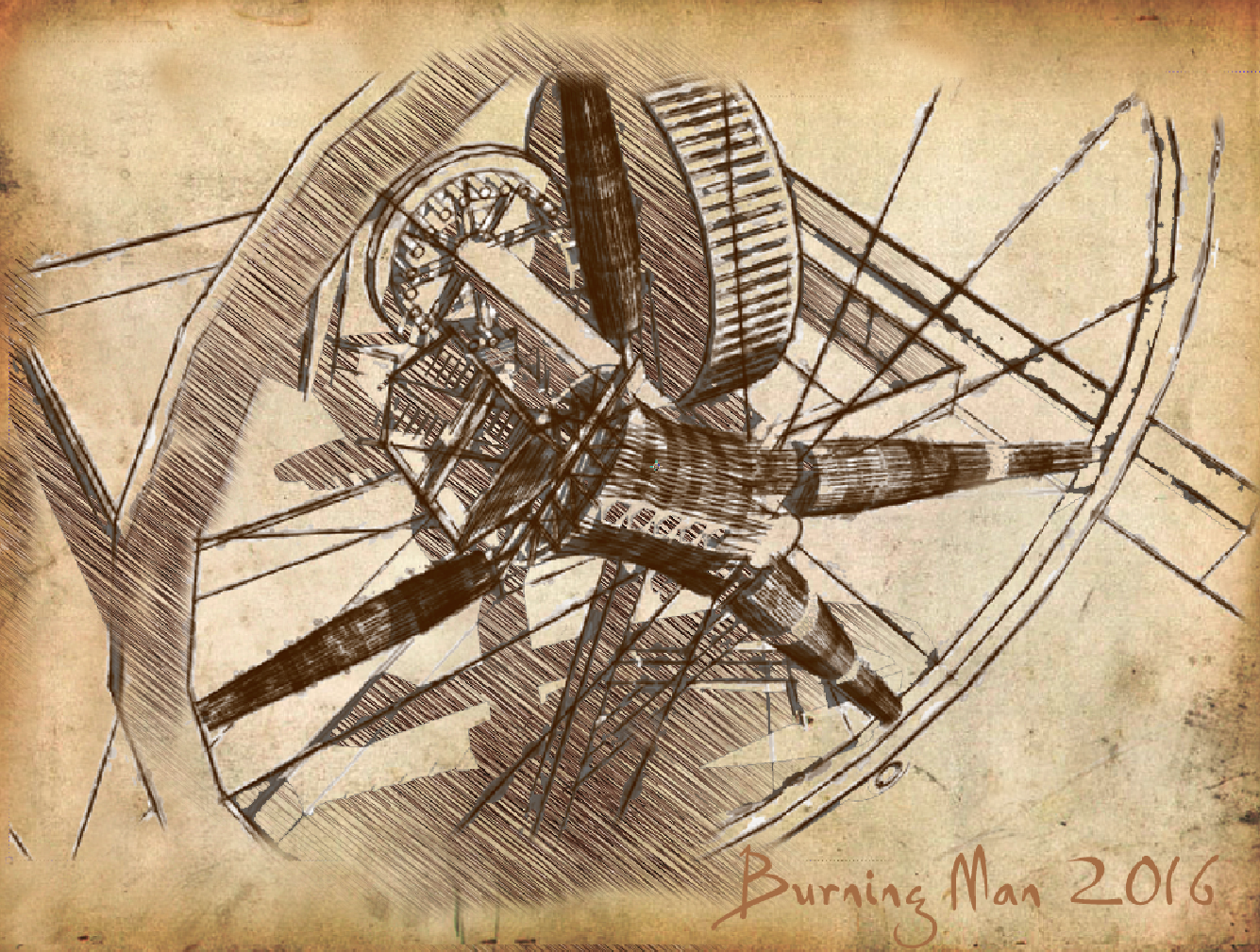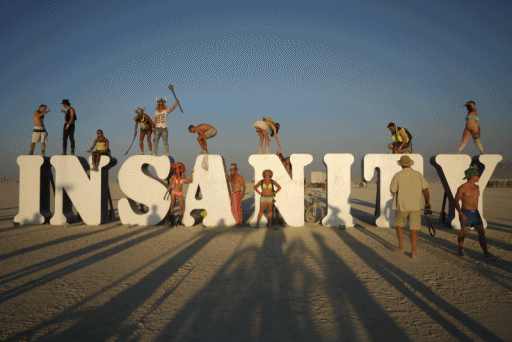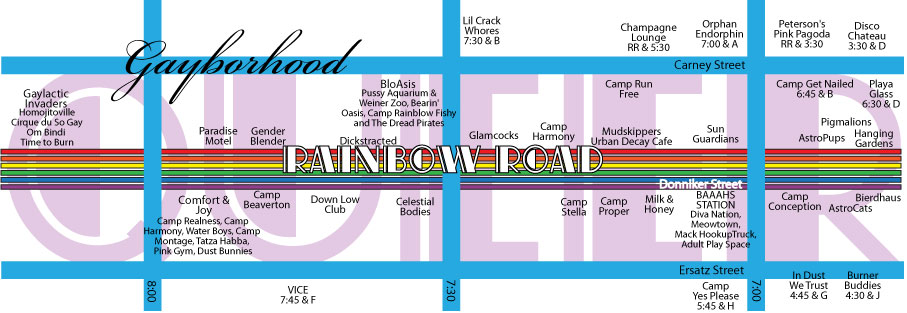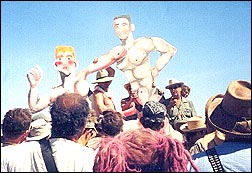Group organizing at Burning Man is a
big topic of discussion this year, and it has led to some very
interesting recounting of how various communities have participated
at the event over the years. This
article, for instance, has some really great insights into the
organizing of raving at Burning Man since 1992. This History of the
Gayborhood is an effort to update the timeline of Queer participation
on the Playa over the years.
1993 – Early Days
In 1993, Burning Man was an event of
about 2000 people and there was no annual ‘theme’ for the
event, there were no organized streets, or registered theme camps. It
was much less governed by rules because it was such a small event,
there wasn’t really a need for rules. Plus, the gathering in
the desert was to make art with fire, and so the anarchist spirit
didn’t really lend itself to rules.
While the event was ‘anarchistic’,
it also was perceived at first by many early gay participants as a
‘straight event’ that was supportive of gay people, but
in the early days, appeared to not be a space where other gay people
were easily found.
Queer San Francisco Experience in
the Early 1990’s
Like the ravers and the San Francisco
Cacophony Society, queer creativity and participation on the Playa
had its roots off the Playa. The context of the early 1990’s
was very shaped by AIDS activism that was very visible at fundraisers
and parties, and these events had an edge that reflected the times.
Queer artists and event promoters who were helping create a wild
queer party scene in San Francisco during the 1990’s helped
create the context for Burning Man participation on the Playa.



Picture Left and Middle – Club
Uranus San Francisco 1991. Pictured Right, Ggreg Deborah Taylor, AKA,
Nambla the Clown. The early 90’s San Francisco “Club
Kids” brought their own style of creativity to the Playa in the
early years of the event. Photos by Mark Geller.
Queer activism and culture in the
1990’s generated from San Francisco sometimes took the form of
performance art and road trip adventures. Queer Nation’s “Mall
Zaps” and the “Lavender Tortoise” road trips to
Reno of the early 90’s organized by art and event promoter
Ggreg Taylor were examples.


Left: The first
Lavender Tortoise road trip to Reno with Roderick McFarland, Leigh
Crow, Jade, Kent Victor Schuelke, Becky Slane, Jim Provenzano, Jim
Rudoff, Jason El Diablo. The Lavender Tortoise trips eventually
became the model for the Trannyshack road trips to Reno. Photos by
Mark Geller.
Right: Veronica Klaus
and Ggreg Taylor at a mall “Zap” organized by Taylor as
the first of its kind in the 1990’s.
In addition to the 1990’s
activist and “Club Kid” culture, many other queer
cultural scenes were happening, such as the Radical
Fairies, Sisters of
Perpetual Indulgence, and others. Like fire performance and other
kinds of radical art and entertainment happening in San Francisco,
the desert became a new place to celebrate radical culture of every
kind that was becoming more regulated in the city of San Francisco as
the 90’s advanced.


Left 1993 Sean Bumgarner and Ggreg
Taylor at club Product.
Right 1993 David Lowe, Nathan
Purkiss and Steven Murphy at club Product.
Queer Club Kids go to the Playa
In 1993, three queer San Franciscans
named Gabriel, Bart and Graham went with a car, a tent, and very
limited supplies to check out Burning Man. They were regulars at
Radical Faerie events, SF clubs etc. and had heard about Burning Man
as an arts event, but didn’t know any friends who were going.
So they went. They didn’t notice any other gay people at the
time, but when they came home, they told all their friends, and
started a tradition of coming home and telling everyone’s
friends about Burning Man. This group eventually grew into the
200-300 person queer Avalon village at the event for many years.
(More on that below…)


The Burning Man event in 1993 was
smaller and followed a rhythm that was possible with roughly 2000
people that is different than with 50,000+ people today. The entire
community could see when anything happened like the start of a
procession with fire breathers, dancers and drums that could be heard
from far away.



Left
photo – the Burning Man raised in 1993 (no elevated platform or
theme these days…).
Center
photo – The Monkey Bean coffee car. This coffee car was
effectively “center camp” in the early days. The only
place you could buy coffee or anything out on the Playa.
Right
Photo – Black Rock Gazette, 1993 edition on the right. It was a
2-sided paper issued Friday and Saturday.
1993 Black Rock
Gazette. Events were listed from Friday to Monday. Below are 1993
Saturday-Sunday events.

From 1993 – 1995, the
event was mostly a Friday to Monday event with some rituals that
happened pretty routinely. During the day people would drive to Fly
Hot Springs or Gerlach for food. At night, random parties would
happen at different camps, but Saturday night there was a procession
of dancers and performers, and a series of art installations being
burned; Sunday night was the Burning of the Man himself. The rave
camp was placed a mile outside of the rest of the camping area, and
after all the fire events finished, everyone would head out to the
raves to dance until sunrise.
YOU
TUBE VIDEO of 1994 Priscilla Queen of the Desert Party with
Stan Christenson, Jim Rudolph, Gabriel Plumlee and others
link here.
(Scott, I have 4
hours of video from 1994 and 1995, but it takes a while to select
sections and convert to digital. Can upload more if you want…)
By 1996, the event grew in size
and some of these routines started to turn into bigger traditions.
The Saturday night procession turned into a full scale opera. The
raves grew from small-ish sound system events to huge parties with
fire performers and a much bigger scale. The whole event adopted an
Inferno “Hell-Co” theme of sorts, which wasn’t
expressed as an official theme, but functioned as an art theme that
was the first time the idea of a theme really came into being.


Left,
Early Avalon Village/Mudskipper community at Fly Hot Springs in
1994.Right the 1994 DayGloasis art project created at the Rave Area
by queer artist Graham Cruickshank with the group that would later
organize the Avalon Village community.
In this period of 1993-1996, Queer
participation was as anarchistic as the rest of the event. There were
no theme camps or very organized anything, but queer people
participated in the event and began building small communities within
the event that would later become larger village communities.


 \
\

1994
Early queer community at Fly Hot Springs left/midle. Nathan Purkiss &
Brian Mays right & Santiago Salsido far right, 1995.



Left
– Nambla the Clown 1996. Middle – Fly Hot Springs 1996. Right –
1995 Saturday Night Procession
1996-1998
Burning Man Transitions to a more organized event
In 1996 Burning Man grew in size to
8000 people and had a series of accidents that required changing the
event. A person drove through a tent and ran over another
participant, and organizers for the event made efforts to maintain
the anarchistic spirit of the event while creating rules to also
promote safety. A map was created for the event and driving (unless
driving a permitted art car) was no longer allowed. Theme camps and
organized participation developed out of this, and the event theme
itself seemed to become an organizing tool. In 1997, the official
theme of “fertility – the living land” seemed
designed as a calming theme after the 1996 inferno.


Left:
1997 poster for the Burning Man Opera; Right: 1997 “fertility”
art
1997 – Is Burning Man Over?
Many 1997 participants wondered if
Burning Man could continue given that it adopted new rules,
especially the rule to ban driving, as it would prevent one of the
best features of the event, driving to Fly Hot Springs to soak for
the day. People also wondered if the organized road map and camps
would kill the anarchistic feeling of the event. But the event
continued to inspire people and work through these changes.
Queer Camps begin to organize on the
Playa
Some of the earliest queer camps began
to organize with the new theme camp system. Early camps that got
started were Jiffy Lube (which became M*A*S*Hcara
for a time), the Black Rock Gym and Beauty Bar (which later became
Avalon Village), and others.
Jiffy Lube & M*A*S*Hcara
While Jiffy Lube had been around since
1995 as a sex-positive space, it registered in 1997 as a theme camp
with a different name – M*A*S*Hcara.
Using its historic “M*A*S*H style tent as an event area, Ggreg
Taylor worked with camp organizers to add a raised backroom entry
into the back of a semi-truck as a sex space with Wizard of Oz
footage playing. Very queer and fun. M*A*S*Hcara lasted a couple
years as a mixed performance art and sex space, until it renamed
itself “Jiffylube” and went back to becoming a mostly
sex-oriented tent. While M*A*S*Hcara had a very short time on the
Playa, it was a concept that was very similar to what would
eventually become Comfort and Joy in later years – a highly
creative space also celebrating sex-positive culture.



M*A*S*Hcara
1998 crew top left. Ggreg Taylor, AKA Nambla the Clown, Top Right
(organizer of M*A*S*Hcara) Camp Jiffy Lube 2000.
2000 The Black Rock Gym and Beauty
Bar
In 2000 the BM theme was “The
Body”, and that year the
Black Rock Gym and Beauty Bar was formed by Gabriel Plumlee, Nathan
Purkiss, Scott Barney, Huck Worden, Victor Torres, John Cordaro,
Patrick Schiller, and others who had been attending Burning Man since
the early 1990’s. The gym included a fully functional dry sauna
to and the beauty bar featured drag artists sharing beauty tips for
anyone who trusted them with makeovers.




Top
Left Black Rock Gym and Beauty Bar. Top Right E-L Wire Black Rock Gym
Sign. Bottom Left – Black Rock Gym fully functional dry sauna.
Bottom Right Spencer Day and Adam Shevel working out at the gym.



Left, Victor Torres
manning the Beauty Bar.
Center, Brian Mays at
the Gym
Right, Gabriel Plumlee
using the Black Rock Gym tanning facilities.
The
Black Rock Gym and Beauty Bar was a first-time theme camp that would
eventually become Avalon Village.
2000 Wind Sock & Tie-die cloth
Installation
In 2000 queer artists Jeff Kennedy and
Xavier Caylor (and others who would later be involved in creating
Audrey’s cabaret), created Playa art installations using
black-light radiant fabric art:


2000
tie-dye windsock art by Xavier Caylor, Jeff Kennedy and others
The giant “wind sock”
fabric art piece included a tie-die tunnel that you could walk
through, as well as other cloth art installations on the playa. Jeff
also later organized a registered theme camp called “Audrey’s
Cabaret” that performed show tunes on the playa for several
years.





Top Left –
Jeff and others walking through the “wind sock”. Top
Middle Jeff Kennedy in 2000. Top right and bottom left – more tie-die
cloth art installations. Bottom Right – Audrey’s cabaret
campmates (photo from Jim Orr).
Jeff had worked with Xavier Caylor
and others to create tie-die fabric art off the Playa for years and
helped organize “Flagging
in the Park” in San Francisco’s Golden Gate Park
before they used their fabric art work to create the wind sock fabric
art installation on the Playa.



Fasdfasd
asdfasd
Left and Middle –
Flagging in San Francisco golden gate park. Right giant ball of
tie-dye art for dance party. Cloth art from queer San Francisco
events was brought to the playa in 2000 as the wind sock
installation.
2002 – Avalon Village


After creating the Black Rock Gym and
Beauty Bar of 2000 and 2001, many of the Gym / Beauty Bar campmates
wanted to start their own projects. Scott Barney wanted to create a
fairy-wing making factory camp called “Fairyland”, and
Huck Worden wanted to create a lush lounge called the Sacrafactory,
Jim Rudolf wanted to create a mobile café to serve Vietnamese
Iced Coffee, and Nathan Purkiss and Gabriel Plumlee wanted to bring
the gym and sauna back again. Instead of breaking up into several
camps, the groups returned in 2002 as Avalon Village.



Left:
Avalon Village plaza 2002, Center:
Avalon Village 2003 with Huck Worden on stilts; Right
Avalon Village Sacrafactory, 2003
Avalon Village formed a community from
2002-2008 joined by several theme camps with about 200-300 people
camping at the village each year, (but about 500 people connected on
lists of the various camps attended on alternating years). The camp
was envisioned as a space for queer people to find other queer
people, and a highly interactive village of artists, performers and
queer / queer friendly community. Activities at the village included
poi spinning classes, fairy wing and tutu making, wrestling matches,
fire dancing, massage workshops, drag performance, queer discussion
groups, parties, daily sober meetings, serving Vitnamese Iced Coffee
daily, and many other activities.

Avalon Village was first
conceived as “the Isle of Avalon” for the Floating World
theme of 2002, but each year a variation on Avalon was decided for
the community, often using acronym A.S.S. for the years when the
community took the name Avalon Space Station and Avalon Synapse
Station, etc.


Left:
Avalon Village art towers on the plaza were lit up at night in blue
LED lights. Pictured here was Astro Pups camp tower.
Right:
Fairyland Wing & Tutu making crafts workshop with art panels and
2nd
story viewing area.
What
was exciting for most of the organizers of Avalon Village was that it
was created by people who were not club promoters or professional
artists in the default world. They
started the Black Rock Gym and Beauty Bar partly because they had
enjoyed Burning Man for so many years without contributing an art
installation or theme camp. So the group felt like they needed to
‘step it up’ and create something.
Once the group made their first theme camp, everyone was hooked and
wanted to do more. It turned into a very committed community for many
years, and many of the community still participate through a camp
that would be formed later called “the Mudskippers”.




Far
Left: Bart Broome attending Burning Man since 1993. Mid Left: Nathan
Purkiss, Adam Shevel and Anthony Ramirez.
Mid
Right: Bryan Hughes DJ’ing. Far Right: Scott Barney and Scott
Stauffer of Fairyland & Avalon Village.




Avalon
Village People:
Far
left: Chris Dayson; 2nd
Left: Viva; Mid-Right: The Plaza in a dust storm. Far right: Rahul
during the post-dust storm rainbow.
Fairyland –
Avalon Village Theme Camp 2002-2008



Fairyland
theme camp organizer Scott Barney in the middle.
Scott
Barney who brought a panoply of craft materials for the Black Rock
Beauty Bar went on at Avalon Village to organize a much larger craft
factory project: Fairyland. Building a beautiful wood frame structure
(one year two stories high) with wall panels that illuminated fairy
murals as the environment, Fairyland hosted an enormously popular
fairy-wing and Tutu-making factory. Wing-making materials made out of
recycled materials (wire hangers et.) and instructions on how to make
fairy wings awaited Burners who came, and people spent hours each day
crafting beautiful fairy wings and tutus of every kind to wear out on
the Playa.






Fairyland
participants John Cordaro (top left) and Steve Heist (bottom left).
Inside
the Fairyland structure (with ladder to 2nd
floor) in the center photos.
Astropups –
Avalon Village Theme Camp from 2003-2008


Left:
Astropup theme camp at Avalon Village; Right: the first Astropups to
arrive in 2000.
In
2003 the Astropups theme camp joined Avalon Village. Organized as a
camp on the Plays since 2000, the Astropups have brought a fun,
frisky, and fabulous nature to the Burning Man Playa in the form of
events, costumes, and personalities. They regularly held wrestling
matches, prom dances, parties and all kinds of good fun for many
years. Like many of the Avalon camps, first and foremost, the camp
was organized to foster a spirit of community and companionship.
Astropups are still
an active camp and their website is: http://www.astropups.com/




Left:
AstroPups David Millard and David Lai at the Gay Prom; Center
left: AstroPup
wrestling match;
Center
Right:
AstroPups organizer Paul Carey; Far
Right:
Brian Maier and other pups at the gay prom.
Superhero
Rendering of Astropups one year (date and artist unknown):












AstSacrafactory
and Thin Air – Avalon Theme Camps 2002-2003
After
making a fully functional dry sauna for the Black Rock Gym, Huck
Worden created two different theme camps for Avalon Village in 2002
and 2003: Sacrafactory and the “Thin Air” lounge.



Left
Photo:
2003 Avalon Village Theme Camp the Thin Air Lounge, was a 1960’s
classic airport lounge with drag hostesses serving cocktails
Right
Photo:
2002 Avalon Village Sacrafactory theme camp. Photo of the entryway
into the SacraFactory, a deep purple lounge reminiscent of an opium
den where participants could invent new sacraments.
Quixotes
Cabaret – Avalon Village Theme Camp 2005-2008
Quixotes Cabaret
is a troupe of performers mostly from the UK who travel to the playa
each year to build a theater with performances both by campmates, and
any participants from the playa who wants to join in their stage
events. They have always been more of a “straight friendly”
group, but they made their home in the queer-friendly Avalon village
for many years. Brit actors are fabulous and fun, and Avalon
Villagers loved that Quixotes chose their home at Avalon for so many
years.
Quixotes are
still active and their current website is here: http://qccb.org/


Photos
of Quixotes Cabaret setting up.
Vietnamese
Iced Coffee Camp – Avalon Village Theme Camp 2002-2008
Avalon
also had a mobile cart that would serve Vietnamese Iced Coffee daily
at the camp, then move out onto the Playa to serve VICC at night!


Ranger
Leaf (Ken Bonnin) left in both; and Sparky (Jim Rudolph) right in
both.
Camp
Montage – Avalon Village Theme Camp 2006-2008


Left
photo:
Nathan Purkiss and RJ Merck. Right
photo:
photographer Wendell Delano.
Camp
Montage formed as an Avalon Village theme camp in 2006 and was the
brainchild of RJ. Merck working with photographer Wendell Delano.
Merck worked with Delano on building his photos into illuminated
montages on large wooden boxes. The montage boxes were
extraordinarily beautiful art pieces recounting images from years of
Burning Man past.

Above
is a collection of Camp Montage photos featured at Avalon Village, as
well as Comfort and Joy and the Afterburn San Francisco events.
Camp Stella –
Avalon Village Theme Camp 2005-2008
Camp
Stella first became a theme camp at Burning Man in 2003 but joined
Avalon Village in 2005. The camp offered a clean and sober space and
daily meetings for Burners.


Emo
(left) and Jefferson (right) Camp Stella Founders John, Bart &
Friend at Celestial Bodies
Other
Camps at Avalon – Celestial Bodies, Temple of Poi & IDC
Over
the years several other theme camps joined Avalon for 1-year stints,
such as Temple of Poi, the Interplanetary Dance Commandos (IDC) and
Celestial Bodies. Temple of Poi hosted fire performances, IDC hosted
a dance space, and Celestial Bodies featured their famous saloon as
part of Avalon Village in 2009.
Avalon Village
“Uncharted Territories” – The Mudskippers
The Uncharted Territories was the community organized by
Nathan Purkiss, Anthony Ramirez, Don Raber, John Marasagan, John
Kisha, Anthony Williams, Gabriel Plumlee, Bart Broome, and others
that provided logistical support for Avalon Village. They built the
Avalon Village sign, lighted the village with solar powered blue
lights, did all of the administrative organizing for the village, and
some years built the Avalon Village Tower in the main plaza of the
village. They also created a “Sunken Pirate Ship”
environment within the village for camp mates to have a community
space within the village.



Left:
Psycho Bunny and Puck hanging out in the sunken pirate ship at
Uncharted Territories
Center:
Cookie Dough hanging out in the Sunken Pirate Ship.
Right:
Uncharted Territories Crew under the Rainbow. (Sean Niles, John
Kisha, John Marasagan, Jody Stevens, Gary Weisler, Nakhter Ahad, Don
Raber at the far right.
Avalon created a
learning opportunity at the Uncharted Territories that can’t be
offered at Burning Man very easily today. Avalon offered for people
who decided at the last minute they wanted to go to Burning Man to
join the Uncharted Territories camp and help work for the village.
Some of our favorite campmates were people who are by nature
spontaneous, and they don’t plan their lives a year in advance
– we wanted them to participate in the creativity of the
community.
Participating in
the Uncharted Territories provided a way to share cultural
information, not only stories of how to promote safety etc., but also
sharing how participants could became active creators of art and
community. This is partly how Camp Montage got its start at Avalon –
RJ Merck came to our village as a newcomer, never coming to Burning
Man before, but after a very inspiring year at Avalon, he came back
to the Playa ready to create one of the most beautiful theme camps of
the village – Camp Montage.



Left:
Daniel and Anthony; Center:
Bart, Nathan and Gabriel; Right:
Rahul
Avalon comes
to a close:
Avalon Village last organized on the
Playa as a village in 2008. The year before, 2007 had been a peak
year with dynamic theme camps, art, a beautiful plaza with multiple
towers lit up with twinkling blue lights, and great energy. By 2008,
many of the campmates were starting to feel burnt out about pulling
together the village for many years. It also seemed that Burning Man
was encouraging the village to break up into theme camps, as we had
feedback from them that the size of our village was unwieldy. Plus,
the American Dream theme turned off some of the queer campmates who
were very angry with George Bush at the time and decided not to go.
Those that did in 2008 still reported having a fantastic time that
year. But times were changing. We wanted something new again.

Puck, Mayor of Avalon Village in
2002
The Mudskippers are Born!

In 2009 the Mudskipper Cafe grew out of the huge
collective “Avalon Village” from what was the camp known
as UT or “Uncharted Territories”. The 2009 Burning Man
theme of “Evolution” was appropriate for the change, and
the name “Mudskippers” represented the fun little
creatures that evolved from water to land roamers. So like the
Mudskipper taking its first step onto land from water, the Mudskipper
cafe took its first step to being an entity in itself.



Mudskipper People
Gayborhood Boom after 2009
In addition to Mudskippers, many other queer camps that
used to participate in Avalon continued to participate on the Playa
as well. Camp Stella, Quixotes Cabaret, Astro Pups and campmates from
all of the Avalon theme camps are still Burners participating at
various levels. In addition to those, other queer camps that had
never participated with Avalon (although were all friends) began to
explode with creativity and participation. Comfort and Joy became a
huge presence on the Playa. And later, the Queer Burners network
became something that Avalon always had tried to do, which was to
develop a catalyst for queer Burners to find each other on and off
the Playa.
Many changes happened that were improvements. New camps
expanded diversity even further adding new creative options on the
Playa. Avalon was a great project, but what used to be a registered
neighborhood during the Avalon years has now exploded into an organic
neighborhood, and that is a big new evolution.
 Ain’t she a pretty girl? This is Scott. He does a lot in the community, perhaps more than you know, not just in the LGBTQ sector. He is one of the founders of Camp Conception out of Seattle. He admins several burning man boards including the Burning Man group (73k members) and Burning Man Classifieds.
Ain’t she a pretty girl? This is Scott. He does a lot in the community, perhaps more than you know, not just in the LGBTQ sector. He is one of the founders of Camp Conception out of Seattle. He admins several burning man boards including the Burning Man group (73k members) and Burning Man Classifieds.
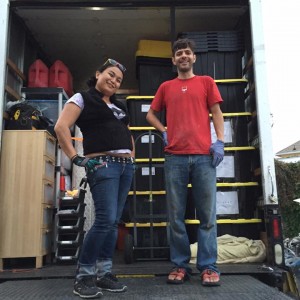 of gender queer and trans folk on the playa.
of gender queer and trans folk on the playa.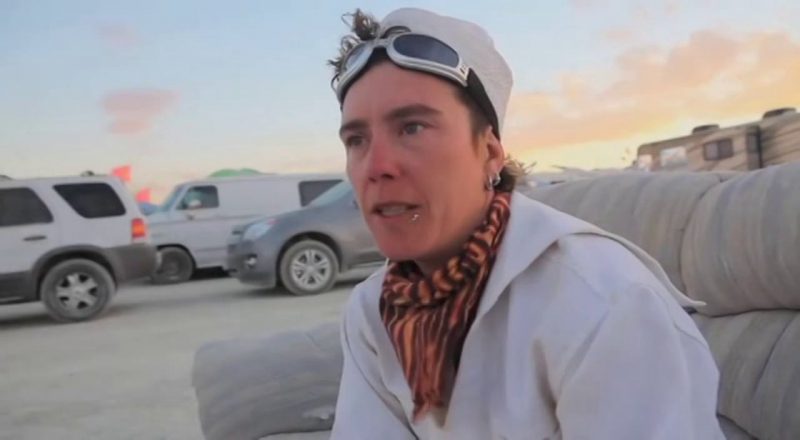
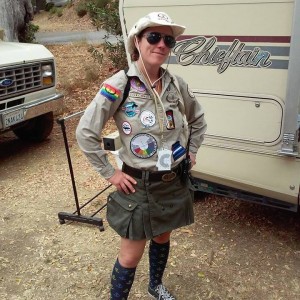 This year she has taken on a new title and something of a new journey by becoming a Ranger; that is a Black Rock City Ranger. It is a role of distinction in our community because these are the people we engage and help us in and outside the trash fence. We have seen how passionate she has become in her new role as a Ranger and how it has made her stronger and a better shaker in the community as a whole.
This year she has taken on a new title and something of a new journey by becoming a Ranger; that is a Black Rock City Ranger. It is a role of distinction in our community because these are the people we engage and help us in and outside the trash fence. We have seen how passionate she has become in her new role as a Ranger and how it has made her stronger and a better shaker in the community as a whole.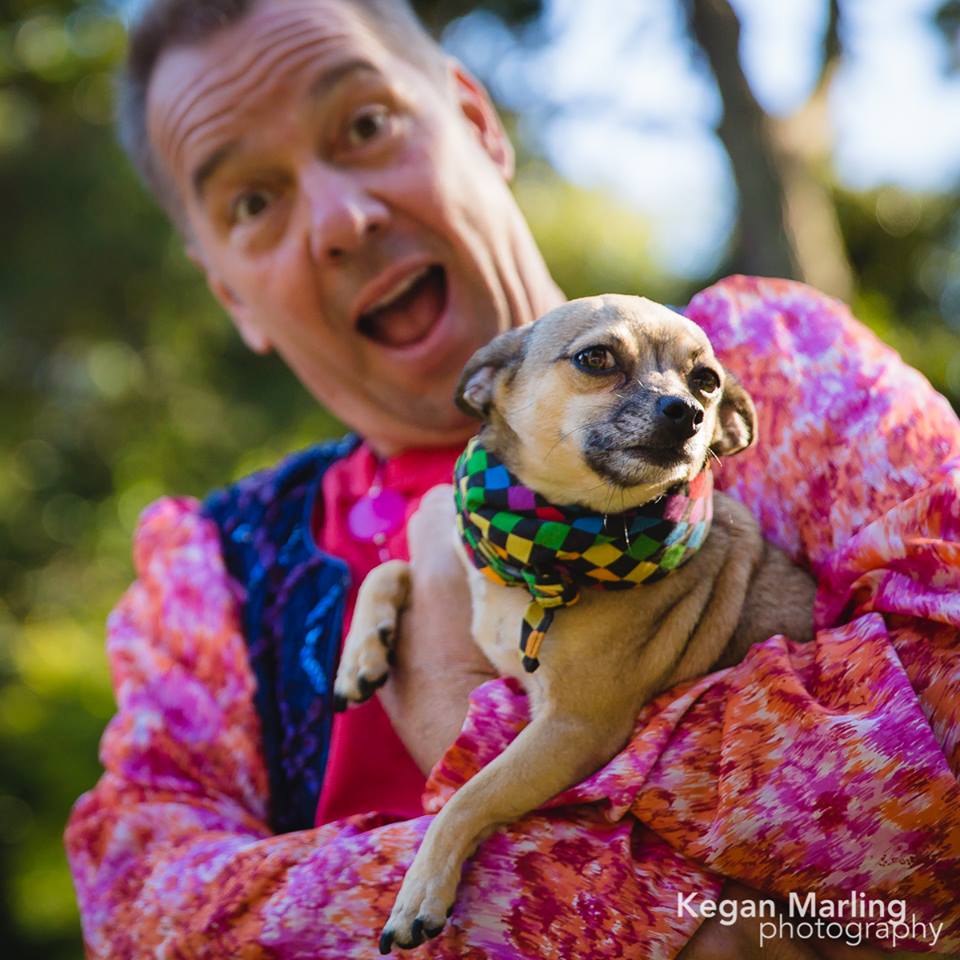
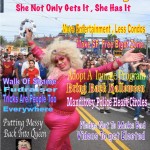

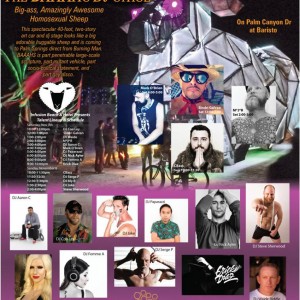 warriors of it’s creation.
warriors of it’s creation. 